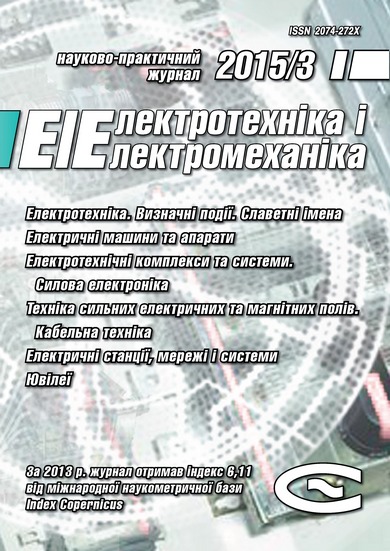CALCULATION OF FIELDS IN A COMBINED INDUCTOR SYSTEM AS A TOOLS OF STRAIGHTENING OF METAL COATING OF CAR BODY
DOI:
https://doi.org/10.20998/2074-272X.2015.3.08Keywords:
combined inductor system, external straightening, low-frequency magnetic fieldAbstract
In the paper construction of combined inductor system realizing the principle of superposition of circular and plane-parallel magnetic fields is proposed. This inductor system is the instrument of external straightening of dents in the metal coating of car body. The use of low-frequency plane-parallel magnetic field instead of a high-frequency magnetic field to create conditions for the transformation of the natural repulsion to attraction of sheet conductor is suggested. The low-frequency field is generated by inductor system by dint of flat circular turn. The plane-parallel magnetic field is generated by a rectangular turn. The low-frequency field penetrates the sheet workpiece in the construct. The theory and experiment indicate that plane-parallel magnetic field doesn’t diffuse almost. Conclusion calculated ratios to analyze the processes of magnetic pulse attraction in the system based on the solution of Maxwell's equations for non-zero intensity components of the electromagnetic field. The Maxwell's equations are transformed by Laplace zero initial conditions. In this case the integral sinus-transformation Fourier are applied. The problem is solved in the plane-wave approximation. Valid for plane waves directly proportional relationship between the tangent vector components of the electromagnetic field on the surface of conductor. For the analysis of processes in combined inductor system for a magnetic-pulsed «pulling» a predetermined part of the metal sheet were obtained the population of calculated expressions. The magnetic pressure on the metal sheet is caused by force action on the part of the excited fields. It is determined solely amplitude of penetrate field and is directed towards the working surface of the inductor. Finally, there is a predetermined part of the attraction of the sheet metal. The operating frequency of the plane-parallel field can be quite small. This choice doesn’t influence the diffusion processes in the system, but allows for the most efficient mode of implementation of a given production operation.References
Batygin Yu.V., Lavinskiy V.I., Bazhinov A.V. Magnetic pulsed methods and systems for attraction of thin sheet metal. Trudy mezhd. nauchn.-tekhn. konf. «Magnitno-impul'snaya obrabotka metallov. Puti sovershenstvovaniya i razvitiya» [Proceedings of Int. Sci.-Tech. Conf. «Magnetic pulsed treatment of metals. Ways to improve and develop»]. Samara (Russia), 18-19 September, 2007, pp. 3-13. (Rus).
Hansen et al. (The Boeing Company). Patent US, no.3.998.081, 1976.
Hendrickson et al. (The Boeing Company). Patent US, no.4.986.102, 1991.
Batygin Yu.V., Lavinskiy V.I., Khimenko L.T. Impul'snyye magnitnyye polya dlya progressivnykh tekhnologiy. Tom 1. Izdaniye vtoroye, pererabotannoye i dopolnennoye. [Pulsed magnetic fields for advanced technologies. Vol.1. 2nd edition, revised and enlarged.] Kharkov, MOST-Tornado Publ., 2003.
p. (Rus).
Turenko A.N., Batygin Yu.V., Gnatov A.V. Impul'snyye magnitnyye polya dlya progressivnykh tekhnologiy. Tom 3: Teoriya i eksperiment prityazheniya tonkostennykh metallov impul'snymi magnitnymi polyami. [Pulsed magnetic fields for advanced technologies. Vol.3: Theory and experiment attraction of thin-walled metal pulsed magnetic fields]. Kharkov, KHNADU Publ., 2009. 249 p. (Rus).
Korn G., Korn T., Spravochnik po matematike [Mathematical Handbook]. Moscow, Nauka Publ., 1973. 831 p. (Rus).
Downloads
Published
How to Cite
Issue
Section
License
Copyright (c) 2015 D. O. Voloncevich, M. V. Barbashova, E. S. Radchenko

This work is licensed under a Creative Commons Attribution-NonCommercial 4.0 International License.
Authors who publish with this journal agree to the following terms:
1. Authors retain copyright and grant the journal right of first publication with the work simultaneously licensed under a Creative Commons Attribution License that allows others to share the work with an acknowledgement of the work's authorship and initial publication in this journal.
2. Authors are able to enter into separate, additional contractual arrangements for the non-exclusive distribution of the journal's published version of the work (e.g., post it to an institutional repository or publish it in a book), with an acknowledgement of its initial publication in this journal.
3. Authors are permitted and encouraged to post their work online (e.g., in institutional repositories or on their website) prior to and during the submission process, as it can lead to productive exchanges, as well as earlier and greater citation of published work.





